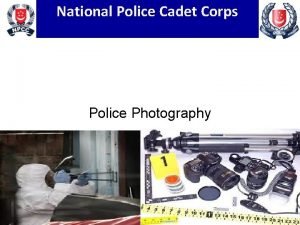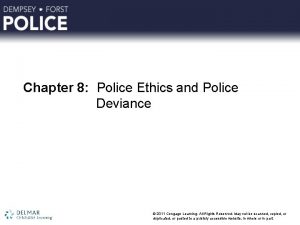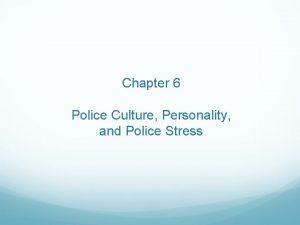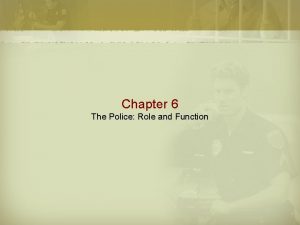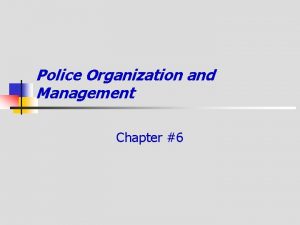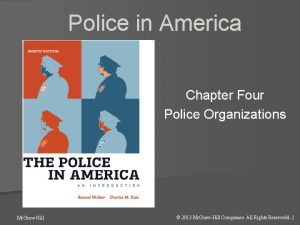Police Technology Chapter Eighteen Technology in the Street





























- Slides: 29

Police Technology Chapter Eighteen Technology in the Street Copyright 2005 - 2009: Hi Tech Criminal Justice, Raymond E. Foster

Learning Objectives n n n Constitutional and case law that has motivated the development of less-lethal use-of-force devices Use of radar and laser technology in traffic Technologies used in vehicle pursuits Gunfire-reduction technology Automated external defibrillators Body Armor Copyright 2005 - 2009: Hi Tech Criminal Justice, Raymond E. Foster

Introduction n Nightstick and revolver were the first technologies police officers used to protect themselves Today, officers carry semiautomatic handguns Shotgun is second-most common firearm carried by police officers Copyright 2005 - 2009: Hi Tech Criminal Justice, Raymond E. Foster

Less-Lethal Use-of-Force Devices n The offender’s actions dictate the Police officer’s response. n n Level 1 – Cooperation Level 2 – Passive Resistance Level 3 – Active Resistance Level 4 – Threat of bodily harm Level 5 – Use-of-force Copyright 2005 - 2009: Hi Tech Criminal Justice, Raymond E. Foster

Less-Lethal Use-of-Force Devices The levels of use of force is not a stair-step approach…in other words an officer may not try one before the other…. the officer chooses the correct response to the offender’s actions…. more link a tool kit. Copyright 2005 - 2009: Hi Tech Criminal Justice, Raymond E. Foster

4 th Amendment & Use-of-force Is the foundation for the use of force by police officers (Search and Seizure) Any time police officers stop someone, they are seizing that person. Copyright 2005 - 2009: Hi Tech Criminal Justice, Raymond E. Foster

Tennessee v. Garner n n n The use of deadly force against an offender who does not appear to pose a threat to police officers or others in unconstitutional. This ruling established the “defense-of-life” standard Introduced the concept that all force must be reasonably applied. Copyright 2005 - 2009: Hi Tech Criminal Justice, Raymond E. Foster

Any form of force can be deadly. Less-lethal use-of-force devices – tools that can overcome offenders’ resistance with a minimum amount of force and minimal injury to the offender and officers. Copyright 2005 - 2009: Hi Tech Criminal Justice, Raymond E. Foster

Less-lethal features n n n Must improve on present practice Must be accessible to the officer yet not overburden the officer. Must be relatively inexpensive Must be ruggedized Cannot require intensive or frequent training Must work under adverse conditions Copyright 2005 - 2009: Hi Tech Criminal Justice, Raymond E. Foster

The Police Baton The most widely used and accepted impact/leverage tool used by police officers. Copyright 2005 - 2009: Hi Tech Criminal Justice, Raymond E. Foster

Chemical Agents Chloroacetophenone (CN) and Orthochlorobenzalmalononitrile (CS) n n Both work on the central nervous system of the offender. Induce pain by activating receptor cells via neural transmitters within the brain. Copyright 2005 - 2009: Hi Tech Criminal Justice, Raymond E. Foster

n CN Burning pain in the eyes, nose, and throat. n n CS Pain in the nose, throat, and chest Can cause nausea and vomiting. Any change in an offender’s system can diminish or negate the effectiveness of the chemical agents (e. g. , drugs, endorphins) Copyright 2005 - 2009: Hi Tech Criminal Justice, Raymond E. Foster

Oleoresin Capsicum (OC) n n n A natural substance found in cayenne pepper. Is an inflammatory agent, not an irritant. Causes swelling of the eyes and breathing passages and burning sensation. Can cause shortness of breath, involuntary closing of eyes and coughing. Photograph provided by ZARC International Copyright 2005 - 2009: Hi Tech Criminal Justice, Raymond E. Foster

Oleoresin Capsicum (OC) n Unlike conventional “tear gas” OC works on dogs Copyright 2005 - 2009: Hi Tech Criminal Justice, Raymond E. Foster

Beanbag Shotgun n n By changing the ammunition, the traditional shotgun is changed to a lesslethal use-of-force device. Projectile is a beanbag -like round. Photograph provided by Defense Technology Federal laboratories Copyright 2005 - 2009: Hi Tech Criminal Justice, Raymond E. Foster

Foam baton round n n n Cousin to the beanbag shotgun. Is a tactical crowd control less-lethal device (to move large groups of people) Fired from a 37 mm launcher. Round ricochets into crowd. Large psychological effect (noise, smoke, flash). Copyright 2005 - 2009: Hi Tech Criminal Justice, Raymond E. Foster

Electrical Control Devices The most common is the Taser. n Handheld, used like a pistol. n Compressed nitrogen is used to propel two projectiles or probes. n The electrical charge interferes with the electrical communication between the brain and the muscles. Copyright 2005 - 2009: Hi Tech Criminal Justice, Raymond E. Foster

Radar Speed Detection The traditional method of speed detection is the radar. n A radar is a transceiver designed to pick up its own RF signals. n Police radar uses a constant RF wave n Good up to about 1, 000 feet Copyright 2005 - 2009: Hi Tech Criminal Justice, Raymond E. Foster

Laser speed detection n n The laser unit reflects light off the violator’s vehicle Using the TDOA formula, calculates the speed of the vehicle. More expensive, but more specific Dedication range of up to 2000 feet Copyright 2005 - 2009: Hi Tech Criminal Justice, Raymond E. Foster

Vehicle Pursuits The first tool is a pursuit policy that guides the actions of police officers during stressful events. Basic technology has not changed - police vehicle emergency lights and sirens Photograph provided by Woodcrest Vehicle Center Copyright 2005 - 2009: Hi Tech Criminal Justice, Raymond E. Foster

How to stop an offender Two common mechanical means: n Tire deflation spikes – difficult to deploy n Precision immobilization technique (PIT maneuver) Copyright 2005 - 2009: Hi Tech Criminal Justice, Raymond E. Foster

Gunfire-Reduction Technology It is nearly as dangerous to fire a gun into the air as it is to fire a gun at someone. When the bullet returns to Earth, it has nearly the same energy that it did on the way up. Copyright 2005 - 2009: Hi Tech Criminal Justice, Raymond E. Foster

Gunfire-Reduction Technology Screen capture provided by Shot. Spotter, Inc. Some new technologies available to detect and locate gunfire use GIS principles to provide local police officers with information as to the location of the gunfire. Copyright 2005 - 2009: Hi Tech Criminal Justice, Raymond E. Foster

Gunfire-Reduction Technology n n n Acoustic devices are placed on telephone poles, rooftops, and streetlamps within a one-square mile area. These devices detect gunfire and feed information about sound and direction to a computer. The computer uses TDOA to determine the location of the gunfire. Copyright 2005 - 2009: Hi Tech Criminal Justice, Raymond E. Foster

Gunshot Residue n n The use of chemicals to detect the presence of gunpowder residue. Technologies are improving so that the techniques can be applying in the field. Copyright 2005 - 2009: Hi Tech Criminal Justice, Raymond E. Foster

Body Armor Soft body armor started out as tire treads (Kevlar). Two basic types of body armor: n Soft n Hard Soft – a series of tightly woven nylon threads that act to disperse the energy of a bullet. Hard – Metal or ceramic plates. It deflects gunfire. Copyright 2005 - 2009: Hi Tech Criminal Justice, Raymond E. Foster

Automated External Defibrillator Your heartbeat is controlled by electrical impulses. Sometimes, these electrical impulses beat out of synchronization. The heart contracts irregularly, does not pump blood throughout your body, and can cause you to die. Copyright 2005 - 2009: Hi Tech Criminal Justice, Raymond E. Foster

If your heart is defibrillated (shocked), survival rates can be high. An automated external defibrillator (AED) is a device designed to allow first responders to diagnose and administer defibrillation. Photograph provided by Cardiac Science, Inc. Copyright 2005 - 2009: Hi Tech Criminal Justice, Raymond E. Foster

Police Technology Explore Military Books at www. military-writers. com Copyright 2005 - 2009: Hi Tech Criminal Justice, Raymond E. Foster
 Great gatsby activities
Great gatsby activities Eighteen month old becca is in the telegraphic speech phase
Eighteen month old becca is in the telegraphic speech phase Street racing technology orchies
Street racing technology orchies Hình ảnh bộ gõ cơ thể búng tay
Hình ảnh bộ gõ cơ thể búng tay Lp html
Lp html Bổ thể
Bổ thể Tỉ lệ cơ thể trẻ em
Tỉ lệ cơ thể trẻ em Gấu đi như thế nào
Gấu đi như thế nào Glasgow thang điểm
Glasgow thang điểm Chúa sống lại
Chúa sống lại Các môn thể thao bắt đầu bằng tiếng đua
Các môn thể thao bắt đầu bằng tiếng đua Thế nào là hệ số cao nhất
Thế nào là hệ số cao nhất Các châu lục và đại dương trên thế giới
Các châu lục và đại dương trên thế giới Công thức tiính động năng
Công thức tiính động năng Trời xanh đây là của chúng ta thể thơ
Trời xanh đây là của chúng ta thể thơ Mật thư tọa độ 5x5
Mật thư tọa độ 5x5 101012 bằng
101012 bằng độ dài liên kết
độ dài liên kết Các châu lục và đại dương trên thế giới
Các châu lục và đại dương trên thế giới Thể thơ truyền thống
Thể thơ truyền thống Quá trình desamine hóa có thể tạo ra
Quá trình desamine hóa có thể tạo ra Một số thể thơ truyền thống
Một số thể thơ truyền thống Cái miệng bé xinh thế chỉ nói điều hay thôi
Cái miệng bé xinh thế chỉ nói điều hay thôi Vẽ hình chiếu vuông góc của vật thể sau
Vẽ hình chiếu vuông góc của vật thể sau Nguyên nhân của sự mỏi cơ sinh 8
Nguyên nhân của sự mỏi cơ sinh 8 đặc điểm cơ thể của người tối cổ
đặc điểm cơ thể của người tối cổ Ví dụ về giọng cùng tên
Ví dụ về giọng cùng tên Vẽ hình chiếu đứng bằng cạnh của vật thể
Vẽ hình chiếu đứng bằng cạnh của vật thể Fecboak
Fecboak Thẻ vin
Thẻ vin
































